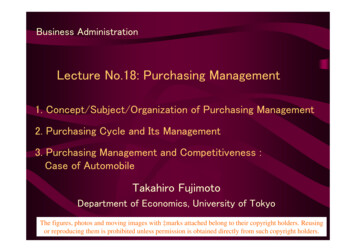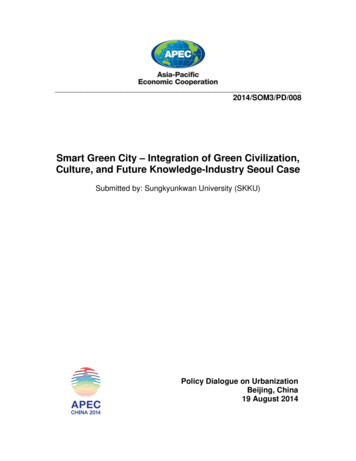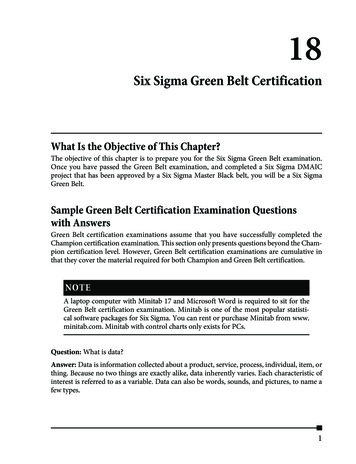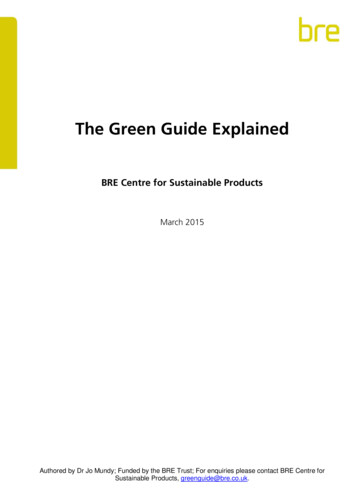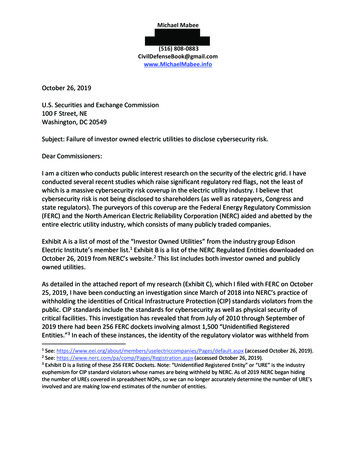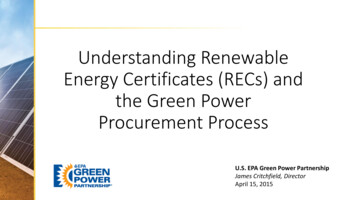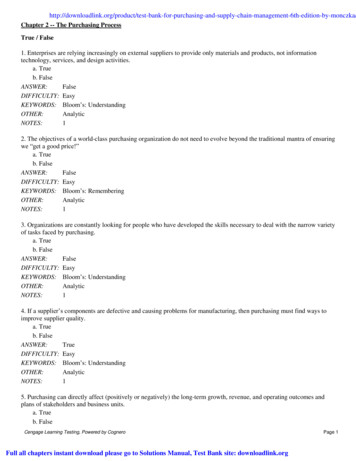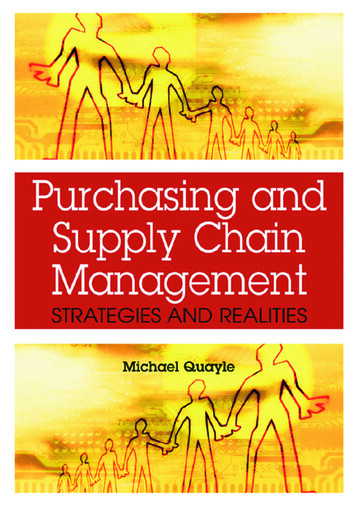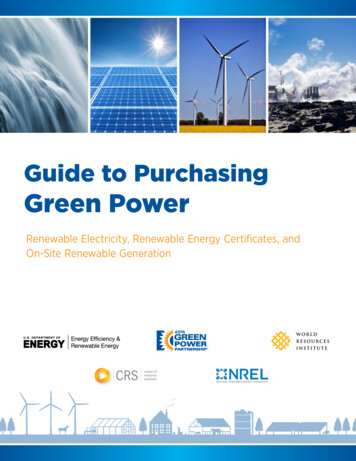
Transcription
Guide to PurchasingGreen PowerRenewable Electricity, Renewable Energy Certificates, andOn-Site Renewable Generation
This guide can be downloaded ng-green-powerOffice of Air (6202J) EPA430-K-04-015www.epa.gov/greenpower March 2010Updated: September 2018ii
TABLE OF CONTENTSSummary vChapter 1Introduction 1-1Chapter 2Introducing Green Power 2-1What is Green Power? 2-3Introduction to Renewable Energy Certificates 2-3Introduction to the Voluntary Market 2-5Certification and Verification 2-5Tracking Systems 2-6Chapter 3The Benefits and Costs of Green Power 3-1The Benefits 3-3The Costs 3-9Public Relations Considerations 3-12Chapter 4Green Power Product Options 4-1Purchase Options 4-4Self-Generation Options 4-9Green Power Supply Options Summary 4-12Chapter 5Using Organizational Goals to Guide Green Power Purchases 5-1Setting Goals 5-4Identifying Key Decision-Makers 5-5Gathering Energy and Facility Data 5-6Choosing Green Power Options 5-8Chapter 6Contracting for Green Power 6-1Developing Criteria for Screening Green Power Suppliers and Products 6-3Collecting Product Information 6-6Creating a Procurement Plan 6-7Chapter 7Planning a Self-Generation Renewable Project 7-1Screening the Options 7-3Obtaining Resources and Assistance 7-4Creating a Project Plan 7-5Installing and Operating a Renewable Generation Project 7-8iii
Chapter 8Capturing the Benefits of the Purchase 8-1The Environmental Benefits 8-3Promoting the Organization’s Purchase 8-5Chapter 9Conclusion 9-1Conclusion 9-3Chapter 10Resources for Additional Information 10-1U.S. Environmental Protection Agency 10-3U.S. Department of Energy 10-3World Resources Institute 10-3Green-e Certification Programs 10-4Glossary 11-1Appendix AGreen Power Considerations for Federal Agencies A-1Introduction A-3Federal Goals and Renewable Usage Information A-3Benefits from Federal Renewable Power Purchases A-5Renewable Procurement Authorities and Regulations A-5Renewable Procurement Approaches A-7GSA, DLA Energy, and WAPA Services A-9Key Elements of a Successful Renewable Procurement A-11Information for Potential Suppliers to the Federal Government A-12Resources A-12Appendix BCommercial Solar Financing Options B-1Introduction B-3Third-Party Ownership Models B-5On-Site Power Purchase Agreement (PPA): Physical PPA B-7Off-Site Power Purchase Agreement (PPA): Financial PPA B-9Lease B-13Loan B-14Cash Purchase B-16Property-Assessed Clean Energy (PACE) B-18Other Financing and Solar Purchasing Options B-20Conclusion B-21Resources B-24Appendix CPurchasing renewable energy as a residential customer C-1Residential consumers can drive demand for green power C-3Purchasing Options for Residential Consumers C-3Verification and Certification C-5iv
SummaryTo view the full Guide, visit een-powerv
SummaryToday, the diverse array of energy resources used to create electricity can produce very different environmentalimpacts. In the United States, power generation is still the nation’s single largest source of industrial air pollution andis a major contributor to greenhouse gas emissions, despite advances in pollution controls over the last 30 years1.Electricity generated from renewable resources such as solar, wind, geothermal, some forms of hydropower, andbiomass has proven to be an increasingly attractive choice for electricity consumers. This Guide to Purchasing GreenPower focuses on voluntary purchases of electricity generated from these renewable resources. It is intended forbusinesses and other organizations that want to diversify their electricity supply and reduce the environmentalimpact of their electricity use. Although renewable resources can also be used for heating and cooling needs or fortransportation, this guide does not address those applications.Green power purchases are attractive to electricity consumers because they allow organizations and individuals touse renewable electricity that is above and beyond what is required by public policy mandates such as the renewableportfolio standards adopted by 29 states and the District of Columbia. Purchases of green power can approach oreven exceed 100 percent of an organization’s electricity use. Green power purchases have and continue to play animportant role in driving the development of new renewable energy projects in the United States (see Figure S-1) andare expected to be an important driver for the overall market for the foreseeable future.A wide range of organizations purchase green power, including federal, state and local governments; universities;businesses; nonprofit organizations; and individual consumers. By purchasing green power, these organizations arehelping protect the environment, meeting their own financial goals, enhancing stakeholder relations and contributingto the development of domestic energy resources. In 2016, renewable electricity generation in the United States(excluding hydropower) approached 342 million megawatt-hours (342 billion kilowatt-hours)—enough to meet theannual electricity needs of over 31 million average U.S. homes.Green power is an effective part of a strategic energy management plan. Successful energy management plansconsider options such as energy efficiency, load management, power purchases, self-generation and non-electric(thermal) energy needs. As with any investment portfolio, the best mix of these options depends on the organization’s goals, the cost of various alternatives, and external market conditions.Over the past 15 years, the market has developed a variety of offerings for electricity consumers, allowing them topurchase green power from renewable sources in verified transactions. The market has gained a wealth of experiencewith voluntary procurement methods, including physical power purchase agreements, green tariffs and financialpower purchase agreement contracts, and self-generation, either on-site or off-site. This latest revision to the Guide toPurchasing Green Power provides an overview and key details on each of these procurement methods.U.S. Environmental Protection Agency. (2015). Sources of greenhouse gas emissions. Retrieved from e-gasemissions.1 vi
Figure S-1. Demand Drivers for Renewable Energy2Otherrenewables4%Other renewables300250200Compliance(new renewables)42%Compliance(new renewables)150Millions of MWhCompliance(existing renewables)Compliance(existing 10201120122013201420152016YearNote: Compliance (new renewables) represents the amount of voluntary sales driven by state programs or policies that require regulated entities to procure RECs from“new” projects, while compliance (existing renewables) are based on sales from existing renewables which account for 26%. Voluntary market sales represent over 27% ofall U.S. non-hydro renewable energy sales in 2016. Other renewables include utility renewable energy purchasing beyond RPS requirements and on-site generation.While voluntary purchases of green power are becoming more common in today’s electricity markets, these marketsoffer many choices. This guide is intended to provide guidance to organizations that have decided to purchase orinvest in green power, as well as organizations that are still considering the merits of green power.The Guide to Purchasing Green Power addresses the following commonly asked questions: What is renewable energy and green power? (p. 3) W hat are the steps for installing on-site renewablegeneration? (p. 47) What is the importance of product certification andverification? (p. 5) H ow do I measure and account for emissions? (p.54) What benefits will my green power purchase bring?(p. 6) How do I communicate my green power purchaseto stakeholders? (p. 55) What is the cost of green power? (p. 12) What are the options for purchasing green power?(p. 17) How should an organization choose a green powerproduct? (p. 27) What are the best ways to buy green power? (p.37)O’Shaughnessy, E., Heeter, J., Cook, J., and Volpi, C. (2017). Status and Trends in the U.S. Voluntary Green Power Market (2016 data). National Renewable i/70174.pdf.2 vii
viii
CHAPTER1IntroductionTo view the full Guide, visit een-power1-1
This Guide to Purchasing Green Power is intended for organizations that are considering the merits of green powerprocurement options, as well as those that have decided to purchase green power and want help doing so. The guidewas written for a broad audience, including businesses, government agencies, universities and other organizations thatwant to diversify their energy supply and reduce the environmental impact of their electricity use. Although it is intendedprimarily for non-residential electricity consumers, residential consumers may also find many of the best practices,processes and guidance on purchasing green power applicable to their purchasing decisions, including more specificinformation in Appendix C.First published in 2004, and previously revised in 2010, this new version of the Guide to Purchasing Green Power providesan overview of green power markets and describes the necessary steps to procure green power. This revision representsa major update to the guide and includes new market information and terminology, updated statistics, new case studies,information on evolving purchasing methods, an updated additional resources section, and new resources for federalagencies and the private sector to use when planning self-generation renewable projects or purchasing green power.This chapter summarizes the guide to help readers find the information they need.Chapter 2 defines green power, clarifies the role of renewable energy certificates (RECs), explains the importance ofindependent certification and verification of green power, and describes the role of REC tracking systems.Chapter 3 summarizes the benefits and costs of purchasing green power.Chapter 4 describes options for purchasing green power products: utility and retail provider options (including greentariffs), direct purchase options (both physical and financial power purchase agreements), community choice aggregationand unbundled RECs; and on-site or off-site self-generation of renewable electricity.Chapter 5 outlines the preparations necessary for buying green power: setting goals, identifying the key decision-makers,gathering energy data, and choosing specific green power options based on availability and feasibility.Chapter 6 discusses the process of contracting for renewable electricity: developing screening criteria, collecting productinformation, drawing up a procurement plan and evaluating the purchase.Chapter 7 describes the steps for owning and operating self-generation: screening the technologies best suited to thepurchaser’s site, obtaining technical and financial resources and assistance, creating a project plan, anticipating possiblebarriers, and installing and operating the on-site generation system.Chapter 8 explores ways to maximize the benefits of buying green power, particularly through greenhouse gas accounting and reporting, promotion to stakeholders both inside and outside the organization, and making accurate claims aboutthe environmental benefits associated with a green power purchase.Chapter 9 summarizes the key concepts and learning insights of Chapters 2 through 8.Chapter 10 offers a list of resources for more information about all aspects of green power. Because electricity fromrenewable resources may be generated in a variety of ways, many institutions are working to facilitate the developmentof green power markets. Several of these organizations’ programs—the U.S. Department of Energy’s Federal EnergyManagement Program, the U.S. Environmental Protection Agency’s Green Power Partnership, the Green Power MarketDevelopment Group of the World Resources Institute, the Center for Resource Solutions, and the National RenewableEnergy Laboratory—collaborated together to write this purchasing guide.The guide also includes a glossary of terms commonly used in the green power field.Finally, Appendix A, Green Power Considerations for Federal Agencies discusses considerations specific to federalagencies that buy green power, particularly the procurement regulations that cover federal acquisition of green power.Appendix B, Commercial Solar Financing Options provides a snapshot of the current commercial solar financing arenaand an overview of existing financing mechanisms. Appendix C, provides green power purchasing guidance for residential consumers1-2
CHAPTER2Introducing Green PowerTo view the full Guide, visit een-power2-1
DOCUMENT MAPSummaryChapter 1.IntroductionChapter 2. Introducing Green PowerWhat is Green Power?Introduction to Renewable Energy CertificatesIntroduction to the Voluntary MarketCertification and VerificationTracking SystemsChapter 3. The Benefits and Costs of Green PowerThe BenefitsThe CostsPublic Relations ConsiderationsChapter 4. Green Power Product OptionsPurchase OptionsSelf-Generation OptionsGreen Power Supply Options SummaryChapter 5. Using Organizational Goals to Guide Green Power PurchasesSetting GoalsIdentifying Key Decision-MakersGathering Energy and Facility DataChoosing Green Power OptionsChapter 6. Contracting for Green PowerDeveloping Criteria for Screening Green Power Suppliers andProductsCollecting Product InformationCreating a Procurement PlanChapter 7. Planning a Self-Generation Renewable ProjectScreening the OptionsObtaining Resources and AssistanceCreating a Project PlanInstalling and Operating a Renewable Generation ProjectChapter 8. Capturing the Benefits of the PurchaseThe Environmental BenefitsPromoting the Organization’s PurchaseChapter 9. ConclusionChapter 10. Resources for Additional InformationGlossaryAppendix A. Green Power Considerations for Federal AgenciesAppendix B. Commercial Solar Financing OptionsAppendix C. Purchasing renewable energy as a residential customer2-2
What is Green Power?The term green power can be used in several differentways. In this guide, green power refers specifically to electricity supplied from a subset of renewable resources thatprovide the highest environmental benefit. Green Poweris also defined as renewable electricity that goes aboveand beyond what is otherwise required by mandate orrequirement – green power is also voluntary or surplusto regulation. Renewable energy is supplied by naturalresources that replenish themselves over short periodsof time without being depleted. Green power is a subsetof renewable energy and represents those renewableenergy resources that provide the highest environmentalbenefit, such as:Figure 2-1. Green Power as a Subset of the U.S.Electricity SectorU.S. Electricity SupplyConventional Energy:coal, nuclear, oil, natural gas(including conventional ways ofusing energy from these sources). SolarRenewable Energy:derived from natural sources thatreplenish themselves over timewithout depleting the earth'sresources. Abundant, available insome capacity nearly everywhere. Notall resources are environmentallybenign.Green Power:electricity generated from a subset ofrenewable resources, including solar,wind, geothermal, biogas, biomass,and low-impact hydroelectricsources. Cause the least environmental damage. Green power is alsovoluntary or surplus to regulation. Wind Geothermal (the earth’s heat) Biogas Biomass (some forms of plant and waste material) Low-impact hydroelectric resourcesGreen power generally does not include some resources that are often considered as renewable energy includinglarge hydropower and municipal solid waste.Green Power and Related TermsThe U.S. energy supply includes a variety of energy resources. Inclusion of specific resources in certain definitionsfor clean or renewable energy is often driven by other factors beyond the environmental profile of the resource.Green power is viewed by the market as a subset of renewable energy which is shown in Figure 2-1. Green power, asdescribed by EPA’s Green Power Partnership, is a term that includes only electricity generated from this subset ofrenewable resources. Readers should keep in mind that the resources associated with renewable energy or greenpower vary depending on the source or program. For more discussion on the definition of green power, please referto the websites of the organizations that collaborated on this guide, listed at the beginning of Chapter 10, Resourcesfor Additional Information.Introduction to Renewable Energy CertificatesDue to the physical nature of electricity and the way it moves across the shared electric grid, it is difficult forconsumers (or utilities) to know precisely the source or origin of the electricity they consume, even with onsiteprojects. The electricity coming through the utility grid can be generated from many different sources and isessentially mixed together prior to consumption. Historically, these generation sources were not tracked from thegenerator to consumer.As states and organizations began developing targets for renewable electricity, a separate system of renewableenergy certificates (RECs) was therefore developed to track generation delivered to the grid to meet consumerdemand. RECs solve the problem of identification, allocation and ownership of renewable energy across a shared2-3
electric grid. Each REC represents 1 megawatt-hour(MWh) of electricity generated and conveys theenvironmental and social attributes of the generatedelectricity to consumers.What is a REC?A renewable energy certificate (REC) is a tradable marketinstrument that represents the generation of 1 megawatt-hour (MWh) of electricity from a renewable energysource.State or regional electronic tracking systems issueRECs to generators that have registered with andreport verified generation to the tracking system.The RECs issued are tradable legal instruments thatare used to verify ownership of the attributes of theenergy generation from the point of generation to thepoint of use. The REC owner has the right to claim theattributes of the renewable electricity.This Chapter introduces the REC and its role as the tracking and accounting instrument for generation and use ofrenewable energy.Chapter 4 reviews RECs and green power product options.The Chapter identifies that RECs are a core instrument toall green power supply options as well as a stand alonesupply option unto itself.”States first created RECs to track compliance withmandatory renewable energy targets for electricity suppliers (also known as state renewable portfolio standards),and in some cases to verify electricity supplier statements to consumers about fuel mix and environmental impacts oftheir electricity. Voluntary or non-regulatory markets and programs invariably require RECs as proof of green powerpurchases, and the Federal Trade Commission has issued environmental marketing guidelines that require ownershipof RECs to substantiate commercial renewable energy claims. This substantiated claims guidance extends not only tothose who claim to be using renewable energy, but also to those who claim to be selling renewable energy, such asrenewable energy project developers.Although there are differences in state definitions of RECs for compliance purposes, state rules and voluntary marketnorms generally agree that the REC instrument provides a legal basis for making green power and other environmental claims. As such, RECs provide an essential accounting and tracking function in renewable energy and green powerclaims.In support of such claims, RECs convey information about each megawatt-hour of electricity generated and consumed: not only whether it is renewable or green but also other details such as the type of fuel or resource used togenerate the electricity, air emissions created during generation, generator capacity, location and year the generatorbegan operation, month or quarter when the electricity on which the REC is based was generated, and other characteristics associated with the generator and generation. These descriptive characteristics are usually referred toas “attributes,” and are important to documenting environmental claims and determining eligibility for programs orfinancial incentives.In addition to being essential to substantiate environmental claims, RECs help avoid double counting and claiming ofthe same generation attributes by mor
describes options for purchasing green power products: utility and retail provider options (including green tariffs), direct purchase options (both physical and financial power purchase agreements), community choice aggregation and unbundled RECs; and on-site or off-site self-generation of renewable electricity. Chapter 5

